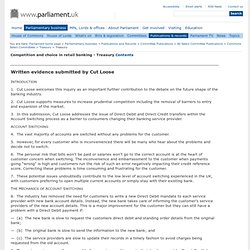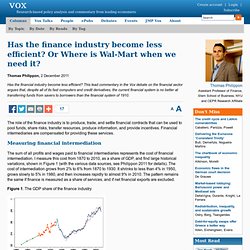

Space opera, beyond finance edition. Cut-Loose-Issues-Paper-Response. Treasury - Written Evidence. Written evidence submitted by Cut Loose 1.

Cut Loose welcomes this inquiry as an important further contribution to the debate on the future shape of the banking industry. 2. Cut Loose supports measures to increase prudential competition including the removal of barriers to entry and expansion of the market. 3. Green Dot Bank: Finally Wal-Mart gets to Play « FinVentures. 16 Jan 2012 GDOT Bank - Federal Reserve Authorization GDOT bought Bonneville Bancorp for $15.7M + $14M Capital Infusion on 8 Dec 2011.

Bonneville was a Utah licensed state bank and a Fed member (regulated by Fed). This is a very significant deal for several reasons: Sets a new regulatory guidepost in the creation of “national” bank with a pre-paid focus. This is a brilliant move by the Fed, and by GDOT. I joined Citi in 2006 with the mandate to grow the retail business without growing the number of branches. What are the core product innovations? Combining a GPR card with retailer brand and distribution (WMT). Banking is a network business.. the GDOT opportunity is to build the network quickly through key retailers (as physical distribution). Today, MSBs are restricted in both offering interest on accounts and the length of time they can hold a balance (escheatment). What to look for: Retailers following this model (including ISIS, Amazon, …). Your thoughts are appreciated.
Like this: Where is Wal-Mart when we need it? The role of the finance industry is to produce, trade, and settle financial contracts that can be used to pool funds, share risks, transfer resources, produce information, and provide incentives.

Financial intermediaries are compensated for providing these services. The sum of all profits and wages paid to financial intermediaries represents the cost of financial intermediation. I measure this cost from 1870 to 2010, as a share of GDP, and find large historical variations, shown in Figure 1 (with the various data sources, see Philippon 2011 for details). The cost of intermediation grows from 2% to 6% from 1870 to 1930. It shrinks to less than 4% in 1950, grows slowly to 5% in 1980, and then increases rapidly to almost 9% in 2010.
Figure 1. Then comes the issue of measuring the output of the financial sector. Figure 2. For the corporate sector, we need to look at bonds and stocks, and for stocks, we want to distinguish seasoned offerings and IPOs. Figure 3. Figure 4. What happened? What Will 2012 Bring for the Banking Industry? — Banking.com. Future of banking - Fais tourner! Digital Banking Gets Personal The digitization of banking, via apps and APIs, will lead to mass personalization.

BYCHRIS SKINNERNov 29, 2011 | 0 Comments A bank is a digital business and, as a digital business, can be broken down into pure bits and bytes. More than that, a bank can be seen as three digital businesses in one: a manufacturer of products; a processor of transactions; and a retailer of services. In this context, the digitization of banking becomes more interesting at a strategic level. First, the products have been deconstructed. This component-based bank demands that every bank capability be put into a basic widget form, or object form if you prefer, and then offered to customers to put together as they see fit. Moving onto processing, we build upon the app-based product view and begin to consider processes as open source code. Finally, the customer relationship has also changed. This is the new augmented reality of customer intimacy through Big Data analysis. Mr.
Process ==> API. Retail ==> Mobile.